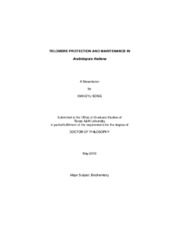| dc.description.abstract | Telomeres are the physical ends of linear chromosomes in eukaryotes. Telomeres
not only protect chromosome ends from being recognized as double-strand breaks but
also maintain the chromosome terminal sequences. These processes involve a number
of telomere-related proteins. A major challenge in the field is to elucidate the full
constitution of telomere-associated proteins and to understand how different protein
complexes are regulated at chromosome termini.
Here, I report the identification and characterization of STN1 (Suppressor of cdc
thirteen, 1), CTC1 (Conserved Telomere maintenance Component 1) and TEN1
(Telomeric pathways in association with Stn1, 1) in Arabidopsis. CTC1/STN1/TEN1
(CST) forms a trimeric complex that specifically associates with telomeres. Loss of any
component of the CST induces catastrophic telomere loss, disrupted telomere end
architecture, and massive chromosome end-to-end fusions. Thus, CST plays an
essential role in chromosome end protection. I also show that CST function at
telomeres is independent of a previously characterized capping complex KU70/KU80,
and that ATR is responsible for a checkpoint response in plants lacking CTC1/STN1.
Additionally, I present data showing that Arabidopsis POT1a (Protection Of
Telomere 1, a) has evolved as a telomerase recruitment factor. Unlike POT1 in other eukaryotes which binds and protects ss telomeric DNA, AtPOT1a interacts with
telomerase RNA (TER). Based on an evolutionary analysis, we found that the POT1a
lineage is under positive selection in the Brassicaceae family in which Arabidopsis
belongs. Mutations of two positive selection sites significantly reduce POT1a?s activity in
vivo. These data suggest POT1a is under pressure to evolve from a telomeric DNA
binding protein to a TER binding protein. I also discovered that POT1a interacts with the
novel telomere capping protein CTC1 in vitro and in vivo. Thus, I hypothesize that
POT1a acts as a telomerase recruitment factor linking this enzyme to the chromosome
termini via interacting with TER and CTC1. Finally, I dissected the functional domains of
POT1a and demonstrated that both the N-terminus and the C-terminus of POT1a are
required for its function in vivo.
In summary, my work has uncovered several new and essential telomereassociated
proteins that provide new insight into mechanisms of chromosome end
protection and maintenance. | en |


